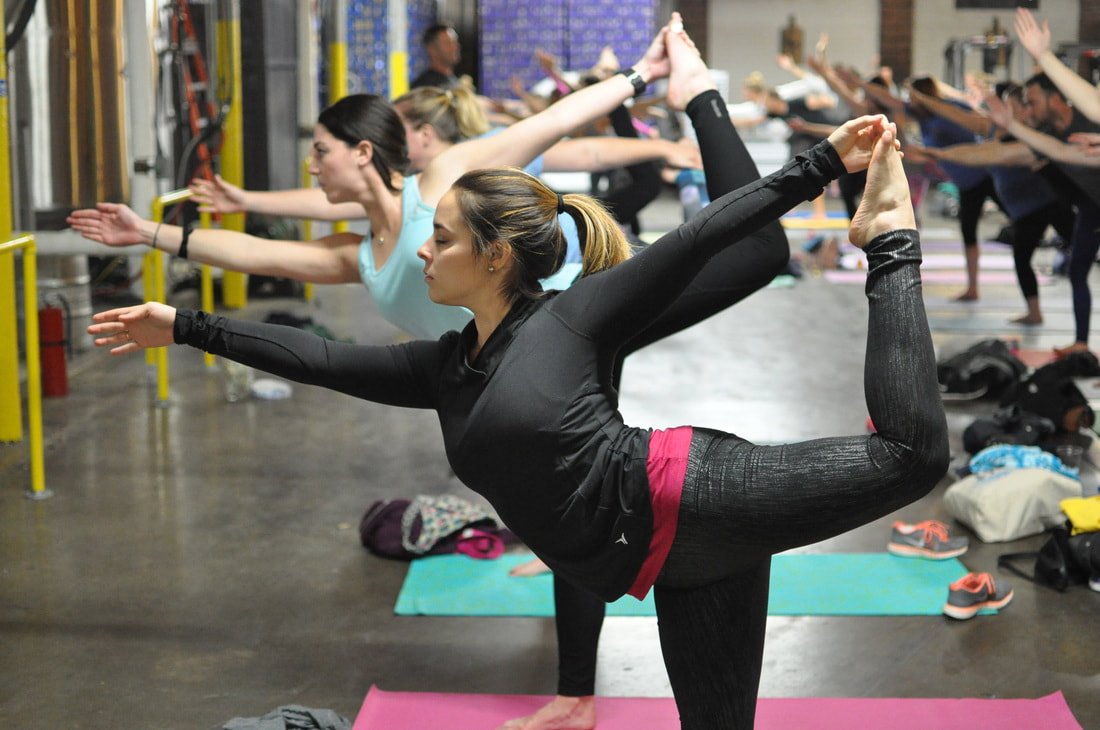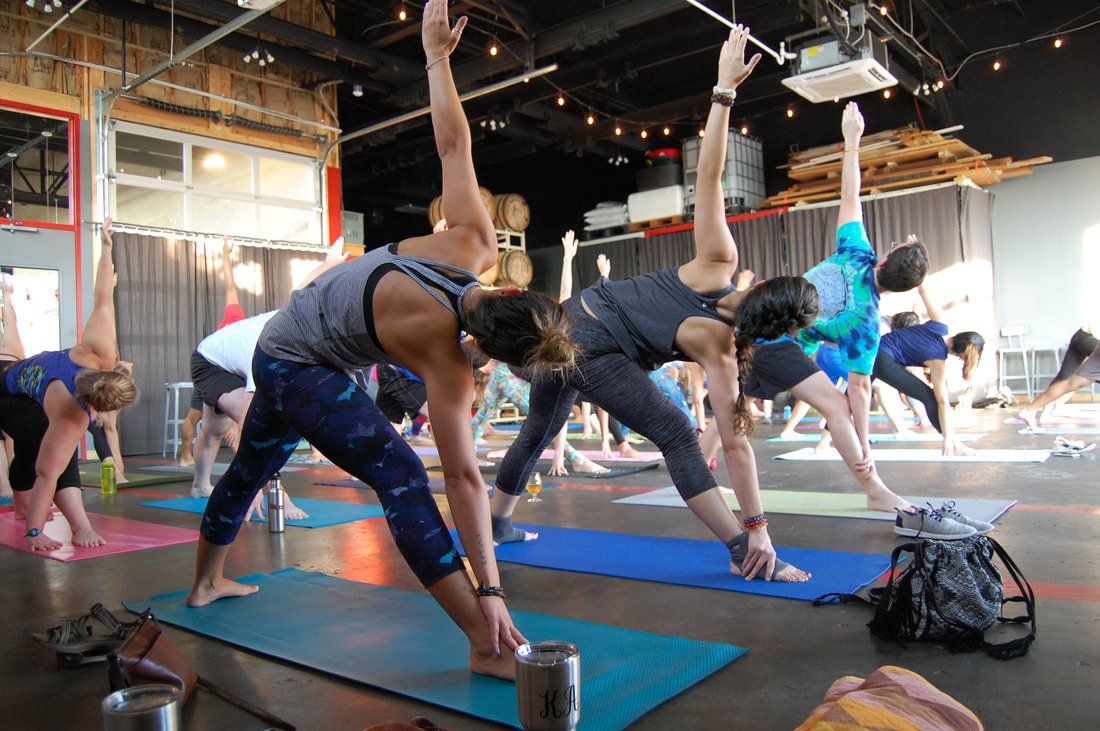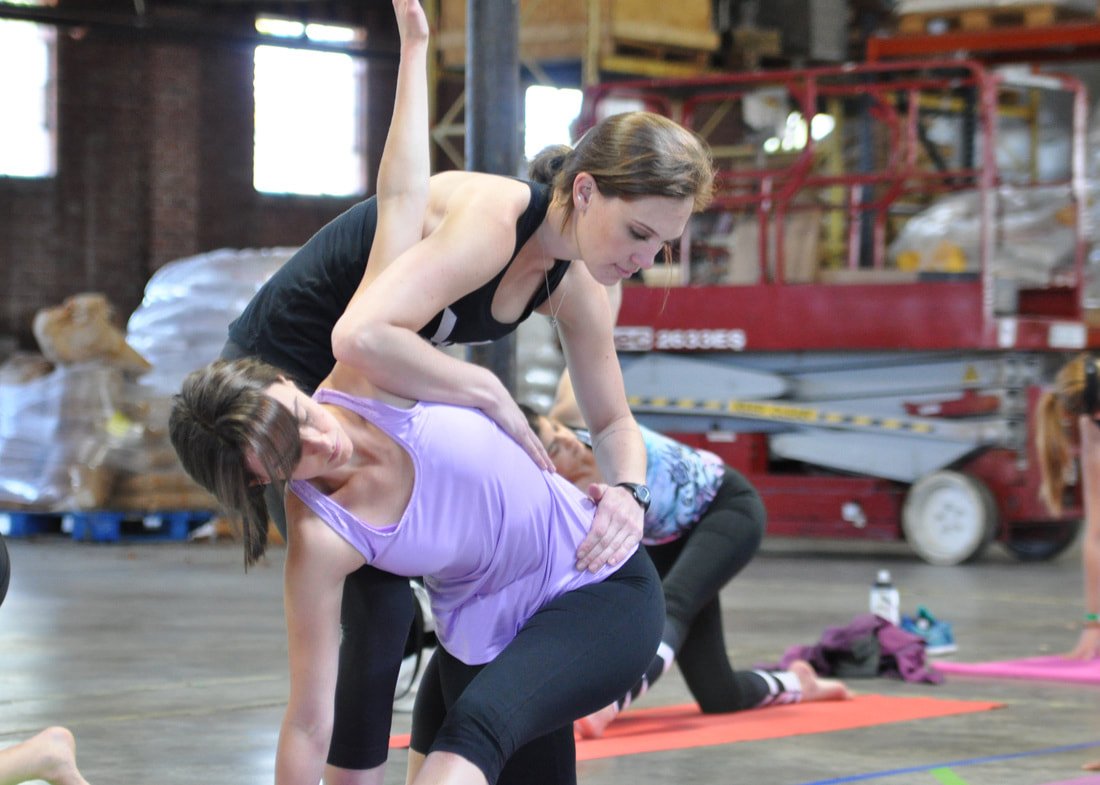What Are The Health Benefits Of Doing Yoga? We Asked An Expert
This content is brought to you in partnership with OrthoCarolina, one of the nation's leading orthopedic practices with offices across the Southeast.
Most days of the week, you can find members of the Work For Your Beer team doing yoga at breweries or other boozeries across the US.
But aside from the savasana and the cold beer waiting for us at the end of class, what are the major benefits that yoga can offer you as a physical practice? We asked Jenni Freie, a Doctor of Physical Therapy and Orthopedic Certified Specialist at OrthoCarolina(and a yoga instructor!) to give us the details.

Let's Cut to the Chase: What Are The Health Benefits of Yoga?
It seems like we hear people talking about how wonderful yoga is and its infinite benefits all the time, usually with a mat slung over their shoulder and a green juice in their hand. But what does the practice actually do for your body?
"I recommend yoga for patients to maintain core strength, to provide postural awareness and strengthening, and for flexibility," Jenni said simply. "Yoga emphasizes proper posture and spinal alignment, which is important for injury prevention."
But don't forget the mental and emotional role that you can get out of some time on the mat! "Yoga can also be helpful with controlling anxiety and reducing the activity level of the nervous system," Jenni added.
Which Types of Athletes Should Consider Trying Yoga?
Yoga can have physical health benefits for almost any type of athlete, as well as the general population. However, we wanted to get a little more specific than that. We asked Jenni to break it down by type of activity so we could better explain why Work For Your Beer community members might want to consider bending for their brew.
"The main benefits for runners are core strength, flexibility, and breath control, as this can improve their running," Jenni told us. "Weight lifters can benefit from flexibility, due to the fact that muscles shorten with strengthening. Cyclists benefit from the flexibility aspect of yoga, as they are in a sitting forward flexed position with repetitive movement. Volleyball players benefit from upper body strengthening for overhead hitting. Golfers can improve their swing with an increase of flexibility and core strength."
So, just about everybody.
Should You Still Try Yoga If You've Experienced An Injury?
If you've recently injured yourself in some way, you might assume that yoga is off the table for you, but Jenni explains that that's not the case. "If you have any injuries or medical conditions, modifications may need to be made during your yoga practice," Jenni said.
So, if you've recently twisted an ankle or have a sprained wrist, these are things you should definitely make your instructor aware of. They'll be able to offer modifications for most poses so you can avoid agitating your injury, and possibly even soothe the injured area.
"If you do have any injuries or medical conditions inform your yoga teacher and/or consult a medical professional," Jenni added. "All yoga instructors do not have a medical degree, and they may not be aware of contraindications or risks for your specific condition."

How Does Restorative Yoga Impact Your Body?
If you've ever seen people doing what looks like slow twisting, bending, and folding in a sequence that looks relaxing, then what you likely saw was a restorative yoga practice. Restorative yoga classes are just that: restorative. Their intent is to calm the mind and body so you can relax and rest in five or six different poses, leaving you feeling refreshed at the end of your flow.
So, what are the physical benefits of this calm, take-it-slow sort of practice?
"It entails longer gentle holds that help to calm the nervous system and get us out of the fight and flight response of the body. It can help to promote healing and muscle repair by increasing blood flow and range of motion to different areas of the body that need recovery," Jenni explained. "This is helpful after intense workouts or intense training regimens. It is helpful to stretch muscles gently without force, as it reduces the risk of causing more damage to the tissue."
As you might expect, restorative yoga offers emotional benefits, as well. "Research has shown that restorative yoga can help to reduce anxiety and improve sleep," Jenni said. Who doesn't want that?
How Does Power Yoga Impact Your Body?
If you've seen or attended yoga classes that flowed quickly from one strength-building pose to another (think Sun Salutations, moving with your breath through high plank, low plank, upward facing dog, downward facing dog... etc.), that sort of vinyasa-based flow is usually considered power yoga. These fitness-based classes aim to increase stamina and flexibility while building internal heat. These are the classes that make people buy towels to bring to yoga!
The physical benefits here are pretty clear, but it's also important to consider the physical risks and proceed with caution to keep your body safe.
"Power yoga classes are designed to increase strength, cardiovascular capacity, and calorie burning. These classes can be faster paced," Jenni said. "Awareness of proper alignment in these classes can be more difficult, placing yourself at risk of injury. Repetitive injuries are also likely. For example, repetitive chaturanga dandasana [or low plank] can fatigue the scapular stabilizer muscles of the shoulders, leading to compensational movements and placing the rotator cuff in risk of injury."
Make sure that you're following your instructor's cues for proper alignment throughout your power flow so you can maximize the physical benefits of the practice, and avoid putting your body in danger.

If You're Totally New To Yoga, Where Should You Start?
We had to ask: what about the newbies? So many of the people in Work For Your Beer's audience are weaning into fitness, and are considering trying yoga for the very first time, but aren't sure where to begin.
"I recommend starting with a slow flow yoga class or beginner yoga class... Selecting the class that is appropriate to your physical health is very important," Jenni explained. "It can often take six to ten classes for you to be comfortable with the current level of yoga class that you are taking. Once you have achieved this, you can consider progressing to a more advanced class. However, practice at your comfort level, and ask for modifications for more challenging poses to prevent injury."
Try A (Beer) Yoga Class Near You Today!
One of the most wonderful things about doing yoga in a brewery is the approachability of practicing in that sort of relaxed environment. It can feel intimidating for someone who's never tried yoga before to walk into a studio where it feels like everyone knows what they're doing, throw down $20 for a drop-in class, and hope for the best. But when you're at a brewery, you're usually paying $10 or less for a class that includes some amount of beer (or another craft beverage) in a stress-free space.
And even if you're not a beginner, brewery yoga classes are a great way to mix up your usual routine and to challenge your ever-evolving practice in new and exciting ways. You might consistently take on the most advanced modifications in your usual studio, but there could be someone in a 75-person brewery warehouse who motivates you to try a new pose or push yourself a little further than you typically would. Embrace that inspiration!
Be sure to tag @workforyourbeer and @orthocarolina on social media as you explore these opportunities to live a healthy and balanced lifestyle.

